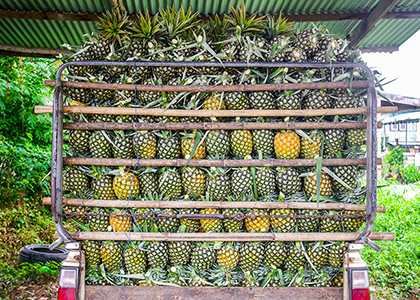
From Farm to Plate: The Journey of Your Produce
By Stacy Kennedy, MPH, RD, CSO, LDN; Reboot Nutritionist
With spring in full gear and summer just around the corner in the northern hemisphere, fresh, deliciously ripe fruits, vegetables and herbs are cropping up in stores and farmers’ markets all around town. Eating locally grown produce has gained popularity for its advantages of higher nutrient content and less likelihood for added pesticides.
Many now consider themselves a “locavore.” Home gardening and school gardens are also back on the rise, with an estimated 18,000 community gardens and 43 million home gardens in the US and Canada. Beyond providing opportunities for education and physical activity, school and community gardens also afford the estimated 40% of US children who attend high-poverty schools food security, specifically a way to easily and consistently have access to anti-obesity, anti-diabetes, health promoting fruits and vegetables.
The Travels of Non-Local Produce
On average, a fruit or vegetable purchased at a US grocery store, will have traveled 1,500 miles from the farm to your plate. And 40% of the fruit Americans consume is grown overseas, according to the USDA Economic Research Service reports. Globally and here in the US, a technical definition for “local” when it comes to produce has yet to be defined although loose guidelines of “within 400 miles,” “within a state or smaller country’s borders,” “a 50km radius of their residence,” and others have been reported.
According to the USDA, “Our definition of local foods includes food for human consumption sold via direct-to-consumer (e.g., farmers’ markets, on-farm stores, farm stands, pick-your-own activities, and other farmer-to-consumer venues).” Since time is one of the factors, in addition to oxygen, heat and light exposure, that can reduce the nutrient levels in produce once picked, eating locally may offer a more nutrient-dense choice.
A Carbon Footprint
The effects on the earth and your health when you eat produce that comes from thousands of miles away is far reaching and goes beyond just nutrition. According to the USDA, Economic Research Service (ERS), farmers sold about $6.1 billion in local foods in 2012, with about 7.8% of US farms offering local sales which in total make up approximately just 1.5% of the value of US agricultural production.
The new dietary guidelines released earlier this year, cite plant-based diet as important not only for our health but also for the environmental benefits. The guidelines pointed out the significant economic and social impact of the extent of our poor diet and lifestyle choices.
Local foods are often touted as reducing the carbon-footprint, or greenhouse gasses (GHG) required in food production and travel. Soil is another determinant of GHG and studies from the UK note a lack of reliable scientific evidence to support these claims that local is indeed better for the environment, in part because studies simply haven’t been conducted in a controlled manner.
The UK experts do note that in-season, local produce compared to non-local fruits and vegetables common sense and somewhat arbitrary evidence to date would suggest the local offers less of a carbon footprint. The issues around true effect and benefits seem to arise once we introduce fresh produce storage and items that are out of season – while these may be packed when fresh, do they retain the nutrient levels once shipped and consumed elsewhere? Also, for meats the determination of carbon footprint needs to look at soil, animal feed and other factors beyond just travel.
How to Eat Locally, More Often
The best way to consume local produce is to grow it at home. Read more here on starting an herb or vegetable garden. Next, seek out farmer’s markets in your area, visit www.localharvest.org for weekly markets and CSAs (community sustainable agriculture) where you get a lovely box full of produce each week from a local farm.
When dining out at restaurants or making choices at grocery stores look for signs indicating which ingredients may have been sourced locally. There are many foods beyond produce that can be either grown, sourced or produced locally as well, supporting the economy of your community. Chocolate, eggs, maple water, honey are just a few examples.
Going local may not only be better for your personal health, it may be good for your community, our environment and the future health of our planet.